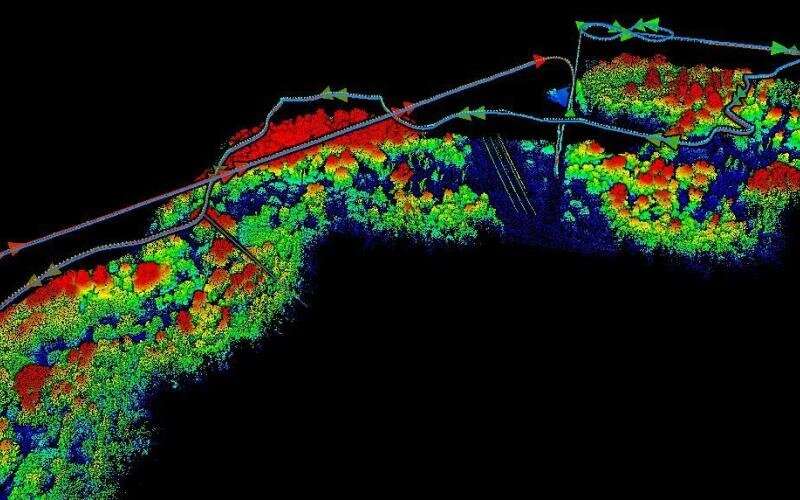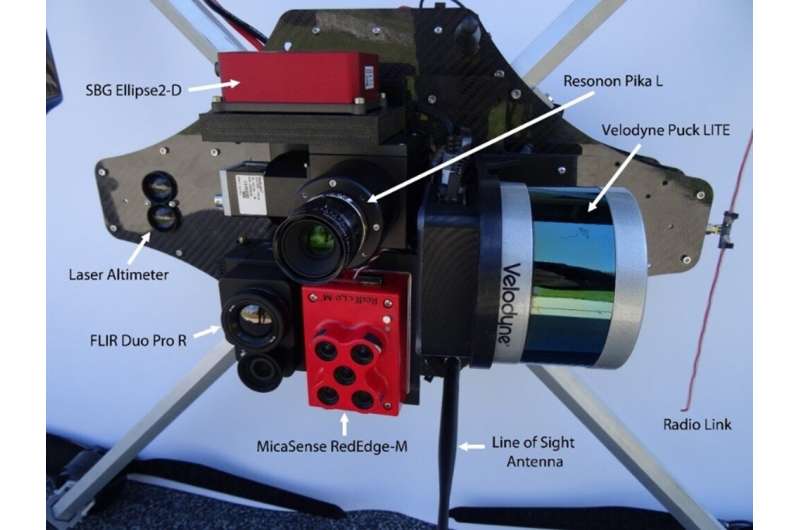
The Autonomous Systems group at the Department of Energy’s Oak Ridge National Laboratory is in high demand as it incorporates remote sensing into projects needing a bird’s-eye perspective.
When it comes to collecting data for environmental and national security research, the team sends its specialized drones to places difficult for a person to reach, improving the quantity and quality of information available to researchers.
ORNL’s Matt Larson, an uncrewed systems research associate, brought the modern technology of autonomous flight to a decades-old research challenge: mercury in the environment.
Environmental researchers in Oak Ridge, Tennessee, have been monitoring mercury levels in local streams for several decades. Mercury is a global pollutant that affects multiple streams on and near the Oak Ridge Reservation. It is transformed to the more toxic and bioaccumulative methylmercury by aquatic microbes that live in periphyton, a complex community of algae, bacteria and detritus that forms on stream bottoms. Drones are being used to map periphyton distribution and abundance to improve understanding of mercury methylation in streams.
Drones can use cameras and other sensors to collect information about the Earth, finding things a researcher on foot may not be able to see.
“Drones are a great way to collect remote sensing data and geospatial data,” said Larson. “We can use hyperspectral sensors, LiDAR (light detection and ranging) and other sensors on the drone to map almost the entire stream, model what we see and help the researchers estimate where the hotspots are.” Hyperspectral sensors are used to detect a wide spectrum of light in many different spectral bands to assist in material identification and characterization while LiDAR uses laser light reflected off surfaces to accurately measure an area.
For this project, Larson loaded up one drone with four commercially available sensors. The variety of sensors makes his aerial platform unique, allowing different types of data to be collected in a single flight without the need to switch out equipment.
But each sensor adds weight to the aircraft, which reduces the amount of time it can stay in the air.
Andrew Duncan, leader of ORNL’s Autonomous Systems group, said each drone has a sweet spot balancing the amount of weight it can carry versus the time it can fly. Cameras, onboard computers, GPS receivers, the frame of the drone, batteries, and other sensors each add mass to the platform.

“By adding more weight, you’re reducing the thrust-to-weight ratio of the aircraft and end up losing flight time,” Duncan said. “We want to maximize flight time.” Ongoing research efforts at ORNL, such as solid-state batteries and other advances in battery lifespan, will improve the performance of aircraft in the future.
Duncan’s team often builds custom sensors—such as a sensor suite to detect radiological material—to go on custom drones. When the right platform for a given mission isn’t available commercially, the team designs and builds exactly what it needs to accomplish its mission. Using ORNL’s 3D-printing capabilities, the team finds the right lightweight and durable material to tailor the chassis.
When the Autonomous Systems team is ready for the next challenge, they load up a mobile command trailer—a recent investment by ORNL—and move out. With a large inventory of uncrewed aerial vehicles, about 80 different aircraft, the team needs an efficient way to get their equipment and communications on location.
“Our unmanned systems trailer allows us to go to a field exercise, be fully self-sufficient and do all of our data collection,” Duncan said. The trailer has workstations with access to a full communications suite connecting to both satellites and FirstNet cellular communications, the government’s priority cellular network. With the capability to generate power, “we can do all of our networking and be self-contained,” Duncan said.
The team took the trailer to Chicago for a three-week data collection event. January in Chicago provided the environment the team needed to collect video and images through winter weather—and the new trailer kept the team warm. “There was a wind chill of 10 degrees one day,” Duncan said. “Previously, we had a van and would set up tents. We have a dedicated team, and now they can be a little more comfortable when they’re out flying.”
As the quest for better flight continues, the group is also turning to a new frontier: water.
A new initiative is underway to improve the nation’s security posture below the waves. Radioactive material is most vulnerable to tampering or theft when it’s moving from one place to another. Currently, there is limited ability to detect if this material is being moved illegally underwater. Larson is leading a project using security concepts from ground transportation to enhance situational awareness with autonomous underwater vehicles.
“Nuclear facilities are always located by water,” Larson said. “Underwater sensors could be used to increase the safety and security of waterways near nuclear facilities to detect a leak or monitor for someone trying to access the facility.”
In the air, on the ground or under water, Duncan and his team are ready to take on the hard problems. “We like to develop a new technology that includes deploying data workflows and architectures,” he said.
They load up the trailer and head out into the rain, snow, cold or sun.
Citation:
Drones give bird’s-eye view for collecting environmental and security data (2023, March 15)
retrieved 15 March 2023
from https://techxplore.com/news/2023-03-drones-bird-eye-view-environmental.html
This document is subject to copyright. Apart from any fair dealing for the purpose of private study or research, no
part may be reproduced without the written permission. The content is provided for information purposes only.
Stay connected with us on social media platform for instant update click here to join our Twitter, & Facebook
We are now on Telegram. Click here to join our channel (@TechiUpdate) and stay updated with the latest Technology headlines.
For all the latest Technology News Click Here
For the latest news and updates, follow us on Google News.
